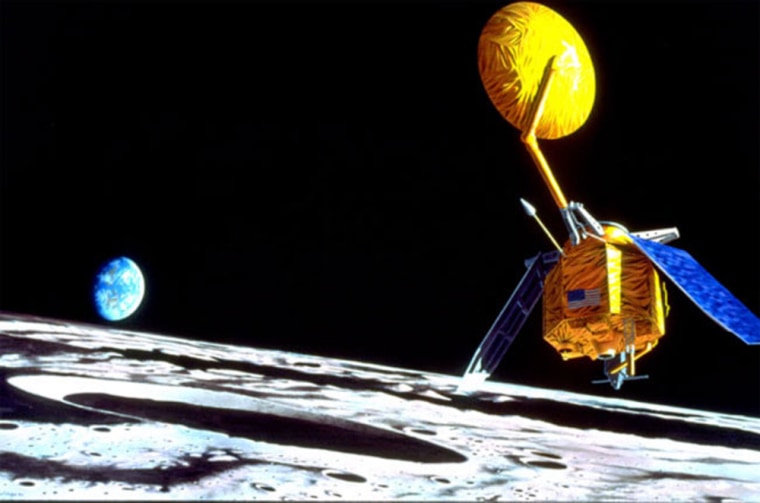NASA engineers are hard at work on a lunar spacecraft expected to be the first in a wave of robotic probes that will pave the way for future human missions.
The spacecraft, called the Lunar Reconnaissance Orbiter (LRO), is the first mission out of the gate under NASA’s space vision of sending more robot and human explorers beyond Earth orbit.
“This mission is the first concrete step in laying the groundwork for humans to go back to the moon,” said Jim Garvin, the lead scientist for moon and Mars exploration at NASA headquarters in Washington. “So there’s a lot resting on its shoulders.”
Set for a 2008 launch, the probe is expected to circle the moon for at least one year and return detailed maps of the lunar surface, data on the moon’s radiation levels and an in-depth look at its polar regions for resources that could be tapped by future astronauts.
But everything is still on paper, and project engineers have a narrow window in which to design, build and integrate the spacecraft to meet their intended launch date.
Engineers at NASA’s Goddard Space Flight Center in Greenbelt, Md., are designing the actual spacecraft bus, while the instrument payload will be provided by private industry. An Acquisition of Opportunity for the payload was announced June 18 and a final design is expected to be in hand in November.
“This is certainly a quick development mission,” Garvin said in a telephone interview. “There’s not a lot of time to generate a high-reliability flight mission.”
Exactly how LRO will make its moon measurements is still an unknown, though mission planners can envision a number of routes private payload designers might take.
“This is not a science mission, it’s a measurement mission,” Garvin said. “For example, we don’t have any lunar maps at the scale of a landing site since the Apollo missions, but there are a variety of ways to make them.”
The instruments involved
LRO’s topographic map-making instruments may include one or more of the following: conventional radar, laser-based range systems like Light Detection and Ranging, or a system known as synthetic aperture radar that combines radar measurements with computer analysis to make detailed measurements.
High-resolution cameras similar to those used in the one-meter resolution Ikonos satellites owned by Space Imaging Inc. will be required to photograph the lunar surface. Part of LRO’s mission is to identify potential landing sites for future missions and any nearby hazards, such as boulders, which could shift and knock a lander or human down, Garvin said.
LRO’s imaging system also is expected to be able to look into permanently shadowed regions of the moon and its polar regions to look for signs of large water ice deposits — on the scale of football fields — that could be viable resources in future missions.
A critical part of any prolonged human stay on the moon is the amount of radiation astronauts will be subject to during a mission. LRO’s instrument set also should be able to determine the biological effects of that lunar radiation environment.
Jim Watzin, lunar exploration program manager at NASA’s Goddard Spaceflight Center, said NASA engineers have already begun preliminary design work on the spacecraft.
Even without a final payload in hand, Goddard engineers have been able to define some of the parameters their spacecraft must meet.
Time constraints
Since time is of the essence, LRO will make use of conventional technology instead of untested tools. That means a chemical-fueled rocket will push the spacecraft moonward as opposed to more exotic approaches, such as an ion engine or other propulsion methods.
A conventional approach also keeps costs down, an important point since the mission’s total budget from development through first-year operations is set at about $90 million.
“We’re constrained to be a Discovery class [mission] in cost, so we have to limit ourselves to a Delta 2 launch vehicle,” Watzin said.
Because of that rocket limitation, project engineers know their final spacecraft must weigh about 1,000 kilograms (2,200 pounds), half of which will be propellant to not only push LRO to the moon, but keep it in the proper lunar orbit once it arrives, Watzin said. And because the spacecraft will be making detailed maps from an altitude of about 50 kilometers (31 miles), LRO will need to be able to accurately point itself in any direction, he added.
The spacecraft will also require a robust power and communications system to relay large amounts of data to Earth and sustain its science instruments.
“We’re pushing the spacecraft design as far as we can go knowing, in general, what the capabilities it needs and having some idea on the classes of instruments it will have,” LRO project manager Craig Tooley said in a telephone interview.
Lunar pathfinder
The future of NASA’s lunar exploration exploits may ride heavily on the data LRO sends back to Earth.
If LRO’s lunar maps point out an obvious point of interest on the surface, the space agency may choose a robot lander mission to drop on the area for a more detailed study. A second possibility would be a second orbiter, armed with more science instruments, to conduct more reconnaissance.
“The early months of [LRO] would target things that the second mission would follow in this lunar robotic program,” Garvin said. “But we’re talking about moderate-class missions here, not billion-dollar, 100-yard wandering rovers.”
